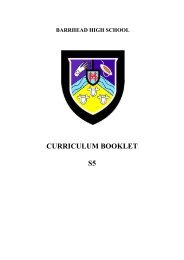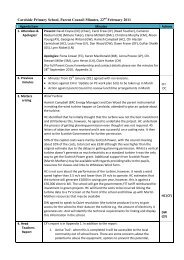Higher Biology 2003 Answers
Higher Biology 2003 Answers
Higher Biology 2003 Answers
Create successful ePaper yourself
Turn your PDF publications into a flip-book with our unique Google optimized e-Paper software.
<strong>2003</strong> <strong>Biology</strong><br />
<strong>Higher</strong><br />
Finalised Marking Instructions
<strong>2003</strong> <strong>Biology</strong> <strong>Higher</strong><br />
Marking scheme<br />
Section A<br />
1. C 11. C 21. B<br />
2. A 12. B 22. D<br />
3. A 13. C 23. A<br />
4. B 14. B 24. A<br />
5. D 15. C 25. B<br />
6. D 16. B 26. D<br />
7. C 17. C 27. D<br />
8. A 18. B 28. A<br />
9. A 19. A 29. C<br />
10. D 20. C 30. B<br />
Page 2
SECTION B<br />
1. (a)<br />
All questions in this section should be attempted.<br />
The diagram below represents cells in the lining of the small<br />
intestine of a mammal.<br />
Marks<br />
digested food<br />
microvilli<br />
A<br />
B<br />
C<br />
(i) The table below gives information about organelles shown<br />
in the diagram.<br />
Complete the table by inserting the appropriate letters,<br />
names and functions.<br />
Letter Name of organelle<br />
E<br />
A<br />
B<br />
C<br />
(ii) Suggest a reason for the presence of microvilli in this type<br />
of cell.<br />
[X007/301]<br />
Rough endoplasmic<br />
reticulum<br />
Mitochondrion<br />
Golgi apparatus<br />
Nucleus<br />
transport<br />
Function<br />
D<br />
E<br />
F<br />
Site of aerobic respiration<br />
Packaging/Processing/<br />
Modifying/Adding<br />
carbohydrate to proteins/<br />
secretions/enzymes<br />
OR Producing glycoproteins<br />
Site of mRNA synthesis<br />
6 correct = 3, 4–5 correct = 2, 2–3 correct = 1<br />
Increased/Large surface area<br />
More rapid/Faster/More efficient diffusion/<br />
uptake/absorption<br />
= 1 mark<br />
= 1 mark<br />
Page three<br />
3<br />
2<br />
Additional Notes
1. (continued)<br />
(d) The diagram below summarises the process of photosynthesis in a<br />
chloroplast.<br />
light<br />
[X007/301]<br />
water<br />
light<br />
dependent<br />
stage<br />
(i) Name molecules X and Y.<br />
X<br />
Y<br />
]<br />
NADPH/NADPH2/reduced NADP<br />
both<br />
glucose<br />
needed<br />
(ii) State the exact location of the light dependent stage within<br />
a chloroplast.<br />
Granum/grana<br />
(iii) Name cycle Z.<br />
Calvin/carbon fixation<br />
(iv) Name the cell wall component referred to in the diagram.<br />
Cellulose<br />
NADP<br />
ADP<br />
+Pi<br />
ATP<br />
X<br />
carbon<br />
dioxide<br />
cycle<br />
Z<br />
oxygen Y<br />
converted to cell<br />
wall component<br />
Page four<br />
Marks<br />
1<br />
1<br />
1<br />
1<br />
Additional Notes
2. An investigation was carried out to compare photosynthesis in oak and<br />
nettle leaves.<br />
Six discs were cut from each type of leaf and placed in syringes<br />
containing a solution that provided carbon dioxide. A procedure was<br />
used to remove air from the leaf discs to make them sink. The<br />
apparatus was placed in a darkened room.<br />
The discs were then illuminated with a lamp covered with a green filter.<br />
Leaf discs which carried out photosynthesis floated.<br />
The positions of the discs one hour later are shown in the diagram<br />
below.<br />
(a) Suggest a reason why the investigation was carried out in a<br />
darkened room.<br />
(b) Explain why it was good experimental procedure to use six discs<br />
from each plant.<br />
(c) In setting up the investigation, precautions were taken to ensure<br />
that the results obtained would be valid.<br />
Give one precaution relating to the preparation of the leaf discs<br />
and one precaution relating to the solution that provided carbon<br />
dioxide.<br />
Leaf discs<br />
[X007/301]<br />
lamp<br />
green filter<br />
solution to<br />
provide<br />
carbon dioxide<br />
Oak<br />
Solution that provided carbon dioxide<br />
Nettle<br />
To prevent entry of other light<br />
OR So discs only receive green light/light from<br />
lamp<br />
Increase reliability/Minimise error due to chance/<br />
Reduce the effect of an atypical result<br />
same size/diameter/mass/weight/<br />
leaf used/thickness/surface area<br />
same concentration/temperature/volume<br />
leaf disc<br />
syringe<br />
Page five<br />
Marks<br />
1<br />
1<br />
1<br />
1<br />
Additional Notes
2. (continued)<br />
(d) Suggest a reason why the leaf discs which carried out<br />
photosynthesis floated.<br />
Gas/Oxygen made so discs are more buoyant/less<br />
dense/lighter<br />
(e) Nettles are shade plants which grow beneath sun plants such as<br />
oak trees.<br />
Explain how the results show that nettles are well adapted as<br />
shade plants.<br />
(f) What name is given to the light intensity at which the carbon<br />
dioxide uptake for photosynthesis is equal to the carbon dioxide<br />
output from respiration?<br />
(g) In another investigation, the rate of photosynthesis by nettle leaf<br />
discs was measured at different light intensities. The results are<br />
shown in the table.<br />
Plot a line graph to show the rate of photosynthesis by nettle leaf<br />
discs at different light intensities. Use appropriate scales to fill<br />
most of the graph paper.<br />
100<br />
0<br />
0 10 20 30 40 50 60<br />
Light intensity (kilolux)<br />
Axes with appropriate scales plus labels with units<br />
(all of table headers)<br />
= 1 mark<br />
Points correctly plotted and joined = 1 mark<br />
[X007/301]<br />
Page six<br />
Marks<br />
They/Nettles can use green light for<br />
photosynthesis<br />
= 1 mark<br />
Shade plants/forest floor receives green light/Light<br />
not absorbed by sun plants/Light transmitted by<br />
canopy<br />
2<br />
Compensation point<br />
80<br />
Rate of<br />
photosynthesis<br />
60<br />
by nettle leaf<br />
discs (units)<br />
40<br />
20<br />
Light<br />
intensity<br />
(kilolux)<br />
10<br />
20<br />
30<br />
40<br />
50<br />
60<br />
Rate of photosynthesis by<br />
nettle leaf discs<br />
(units)<br />
2<br />
26<br />
58<br />
89<br />
92<br />
92<br />
1<br />
1<br />
2<br />
Additional Notes
2. (continued)<br />
(h) From the table, predict how the rate of photosynthesis at a light<br />
intensity of 50 kilolux could be affected by an increase in carbon<br />
dioxide concentration. Justify your answer.<br />
increase/rise CO<br />
Effect Justification 2 limiting OR<br />
Effect stay the same Justification temperature<br />
limiting/CO2 not<br />
limiting<br />
[X007/301]<br />
Page seven<br />
Marks<br />
1<br />
Additional Notes
3. The stages shown below take place when a human cell is invaded by an<br />
influenza virus.<br />
(a) Describe the processes that occur during Stages 2 and 5.<br />
Stage 2<br />
Stage 5 Nucleic acid/DNA/RNA enters/<br />
joins with viral/protein coats OR Viruses assembled<br />
OR New viruses made<br />
(b) Name the cell organelle at which the viral coats are synthesised<br />
during Stage 4.<br />
(c) During a viral infection, a type of white blood cell is stimulated to<br />
make antibodies which inactivate the viruses.<br />
(i) Name this type of white blood cell.<br />
[X007/301]<br />
Stage 1 Viral nucleic acid enters host cell<br />
Ribosome<br />
Lymphocyte<br />
Stage 2<br />
Stage 3 Viral nucleic acid replicates<br />
Stage 4 Synthesis of viral coats<br />
Stage 5<br />
Stage 6 Rupture of cell and release of viruses<br />
Viral nucleic acid/DNA/RNA takes over/<br />
alters cell metabolism<br />
OR Viral DNA inactivates host DNA<br />
(ii) What feature of viruses stimulates these cells to make<br />
antibodies?<br />
Surface protein/foreign protein/antigen<br />
(iii) New strains of influenza virus appear regularly. Suggest<br />
why antibodies produced against one strain of virus are not<br />
effective against another strain.<br />
Antibodies/They are specific OR Other viruses<br />
not recognised OR Antigen is different<br />
OR Antigen does not match antibody<br />
Page eight<br />
Marks<br />
1<br />
1<br />
1<br />
1<br />
1<br />
1<br />
Additional Notes
4. An outline of the process of respiration is shown in the diagram below.<br />
hydrogen<br />
(a) Apart from glucose and enzymes, what chemical substance is<br />
essential for glycolysis to occur?<br />
(b) Name the end-product(s) of anaerobic respiration in an animal<br />
cell and a plant cell.<br />
(i) Animal cell<br />
(ii) Plant cell<br />
(c) Name the carrier that transfers hydrogen to the cytochrome<br />
system.<br />
(d) Explain why the cytochrome system cannot function in anaerobic<br />
conditions.<br />
No oxygen available as (final) hydrogen acceptor<br />
(e) The energy content of glucose is 2900 kJ mol –1 and during<br />
aerobic respiration 1178 kJ mol –1 of this energy is stored in ATP.<br />
Calculate the percentage of the energy content of glucose that is<br />
stored in ATP.<br />
Space for calculation<br />
(f) Which stage of respiration releases most energy for use by the<br />
cell?<br />
[X007/301]<br />
4-carbon<br />
compound<br />
hydrogen<br />
ATP<br />
glucose<br />
pyruvic acid<br />
acetyl-CoA<br />
Krebs<br />
cycle<br />
5-carbon<br />
compound<br />
glycolysis<br />
Coenzyme A<br />
(CoA)<br />
cytochrome system<br />
Lactic acid<br />
citric acid<br />
Ethanol/alcohol and carbon dioxide<br />
NAD/NADH/NADH 2/Reduced NAD<br />
end product(s) of<br />
anaerobic respiration<br />
oxygen<br />
water<br />
OR Oxygen is needed to accept/ combine with/join<br />
to/receive hydrogen<br />
40 . 6<br />
Cytochrome system/Hydrogen transfer system<br />
Page nine<br />
%<br />
Marks<br />
1<br />
1<br />
1<br />
1<br />
1<br />
1<br />
1<br />
Additional Notes
5. The diagram below represents a stage of meiosis in a cell from a female<br />
fruit fly, Drosophila.<br />
R<br />
(a) Name the tissue from which this cell was taken.<br />
(b) What is the haploid number of this species?<br />
(c) Chromosomes R and S are homologous. Apart from their<br />
appearance, state one similarity between homologous<br />
chromosomes.<br />
(d) Explain the importance of chiasmata formation.<br />
[X007/301]<br />
Ovarian/Ovary<br />
4<br />
Same genes/Genes for same characteristics<br />
chiasma<br />
Increases variation/Produces recombinants/Produces<br />
new allele combinations/Increases genetic diversity<br />
S<br />
Page ten<br />
Marks<br />
1<br />
1<br />
1<br />
1<br />
Additional Notes
6. In humans, the allele for red-green colour deficiency (b) is sex-linked<br />
and recessive to the normal allele (B).<br />
The family tree diagram below shows how the condition was inherited.<br />
(a) Give the genotypes of individuals S and T.<br />
(i) S<br />
(ii) T<br />
(b) If individuals Q and R have a son, what is the chance that he will<br />
inherit the condition?<br />
Space for calculation<br />
Chance<br />
(c) Explain why individual R has the condition although her mother<br />
was unaffected.<br />
[X007/301]<br />
Male without the condition<br />
Male with the condition<br />
Female without the condition<br />
Female with the condition<br />
Q R S T<br />
X B X b<br />
X b Y<br />
100%/1 in 1/certainty/<br />
He will have it<br />
R received X b /the recessive allele from both parents<br />
and mother is a carrier<br />
Page eleven<br />
Marks<br />
1<br />
1<br />
1<br />
1<br />
Additional Notes
7. Hawaii is a group of islands isolated in the Pacific Ocean.<br />
Different species of Honeycreeper birds live on these islands.<br />
The heads of four species of Honeycreeper are shown below.<br />
(a) (i) Explain how the information given about Honeycreeper<br />
species supports the statement that they occupy different<br />
niches.<br />
(ii) What further information would be needed about the four<br />
species of Honeycreeper to conclude that they had evolved<br />
by adaptive radiation?<br />
(b) The Honeycreeper species have evolved in geographical isolation.<br />
Name one other type of isolating barrier involved in the evolution<br />
of new species.<br />
[X007/301]<br />
Beaks different so birds eat different foods/<br />
have different feeding methods<br />
Descended from/Fossil evidence of/Share a<br />
common ancestor<br />
Reproductive OR Ecological<br />
Page twelve<br />
Marks<br />
1<br />
1<br />
1<br />
Additional Notes
8. The marine worm Sabella lives in a tube made out of sand grains from<br />
which it projects a fan of tentacles for feeding.<br />
fan of tentacles<br />
(a) If the worm is disturbed, the fan is immediately withdrawn into<br />
the tube.<br />
The fan re-emerges a few minutes later.<br />
(i) Name the type of behaviour illustrated by the withdrawal<br />
response.<br />
(ii) What is the advantage to the worm of withdrawing its<br />
tentacles in response to a disturbance?<br />
(b) If a harmless stimulus occurs repeatedly, the withdrawal response<br />
eventually ceases.<br />
[X007/301]<br />
Avoidance/escape<br />
Defence against predators/protection/avoid<br />
injury/less likely to be eaten<br />
(i) Name the type of behaviour illustrated by this modified<br />
response.<br />
Habituation<br />
tube of sand<br />
grains<br />
(ii) What is the advantage to the worm of this modified<br />
response?<br />
Saves/Conserves/Uses less/Does not waste energy<br />
OR Does not use energy responding to a harmless<br />
stimulus<br />
OR Can continue feeding<br />
Page thirteen<br />
Marks<br />
1<br />
1<br />
1<br />
1<br />
Additional Notes
9. Limpets (Patella) feed by grazing on algae growing on rocks at the<br />
seashore.<br />
limpet Limpet shell<br />
height<br />
Average<br />
shell<br />
length<br />
(mm)<br />
length<br />
Graph 1 below shows the effects of limpet population density on the<br />
average shell length and total biomass.<br />
Graph 1<br />
80<br />
60<br />
40<br />
20<br />
0 20 40 60<br />
Population density (limpets per m2 0<br />
0<br />
80 100<br />
)<br />
(a) What is the total biomass at a population density of 10 limpets per<br />
m 2 ?<br />
g per m 2<br />
(b) Identify the population density range (limpets per m 2 ) in which<br />
the total biomass increases most rapidly.<br />
Tick the correct box.<br />
0 –10 10 –20 20 –30 30 – 40 40 –50<br />
(c) Calculate the average mass of one limpet when the population<br />
density is 20 per m 2 .<br />
Space for calculation<br />
Average mass 5 g<br />
(d) Use values from Graph 1 to describe the effect of increasing<br />
population density on the total biomass of limpets.<br />
[X007/301]<br />
25<br />
✓<br />
200<br />
150<br />
100<br />
50<br />
Key<br />
Average<br />
shell length<br />
Total<br />
biomass<br />
Total biomass<br />
(g per m 2 )<br />
(1) As population density increases the total biomass<br />
increases<br />
(2) Up to a population density of 40 per m2 (3) At a total biomass of 125g per m 2<br />
(4) After this the total biomass stays constant<br />
ALL 4 points for 2 marks<br />
ANY 3 points for 1 mark<br />
Page fourteen<br />
Marks<br />
1<br />
1<br />
1<br />
2<br />
Additional Notes
9. (continued)<br />
Shore A<br />
(sheltered)<br />
Shell<br />
height<br />
(mm)<br />
16<br />
19<br />
20<br />
21<br />
22<br />
23<br />
26<br />
(e) Explain how intraspecific competition causes the trend in average<br />
shell length shown in Graph 1.<br />
At high population density/As population density<br />
increases, there is greater competition between<br />
limpets so (average) shell length decreases<br />
(f) The table below shows information about limpets on shore A<br />
which is sheltered and on shore B which is exposed to strong wave<br />
action.<br />
Graph 2 below shows the effect of wave action on limpet shell<br />
index.<br />
Shell<br />
length<br />
(mm)<br />
52<br />
54<br />
55<br />
56<br />
57<br />
58<br />
60<br />
[X007/301]<br />
Limpet shell index =<br />
Shore B<br />
(exposed)<br />
Shell<br />
height<br />
(mm)<br />
9<br />
11<br />
14<br />
16<br />
17<br />
17<br />
–<br />
Shell<br />
length<br />
(mm)<br />
21<br />
26<br />
31<br />
34<br />
35<br />
36<br />
–<br />
Average Average Average Average<br />
= 21 =<br />
= 14 =<br />
(i) Complete the table by calculating the average shell<br />
length of limpets on both shores.<br />
Space for calculation<br />
(ii) Express as the simplest whole number ratio the average<br />
shell height for shore A and shore B.<br />
Space for calculation<br />
Ratio 3 : 2<br />
(iii) A limpet shell collected on one of the shores had a length<br />
of 43 mm and a height of 20 mm. Use Graph 2 to identify<br />
which shore it came from and justify your choice.<br />
Tick (✓) the correct box Shore A Shore B<br />
Justification<br />
Shell index shows it came from a region with<br />
strong wave action<br />
shell height<br />
shell length<br />
Shell<br />
index<br />
(units)<br />
0 . 6<br />
0 . 4<br />
0 . 2<br />
0<br />
Graph 2<br />
Increasing force of wave action<br />
56 30 . 5/31 (both required for 1 mark)<br />
✓<br />
Page fifteen<br />
Marks<br />
1<br />
1<br />
1<br />
1<br />
Additional Notes<br />
OR At low population density/As<br />
population density decreases, there<br />
is less competition between limpets<br />
so (average) shell length increases
10. (a) The grid below shows adaptations of bony fish for<br />
osmoregulation.<br />
A<br />
D<br />
Use letters from the grid to answer the following questions.<br />
(i) Which three adaptations would be found in freshwater<br />
fish?<br />
Letters C , D and F .<br />
(ii) Which two adaptations would result in the production of a<br />
small volume of urine?<br />
Letters A and E .<br />
(b) The table shows some adaptations of a desert mammal which help<br />
to conserve water.<br />
For each adaptation, tick (✓) the correct box to show whether it is<br />
behavioural or physiological.<br />
[X007/301]<br />
few, small<br />
glomeruli<br />
active uptake of<br />
salts by gills<br />
B<br />
E<br />
active secretion<br />
of salts by gills<br />
low filtration<br />
rate in kidney<br />
C<br />
high filtration<br />
rate in kidney<br />
many, large<br />
glomeruli<br />
Adaptation Behavioural Physiological<br />
High level of blood ADH<br />
Lives in underground burrow<br />
Nocturnal foraging<br />
Absence of sweating<br />
All 4 correct = 2 marks 2 or 3 correct = 1 mark<br />
✓<br />
✓<br />
F<br />
✓<br />
✓<br />
Page sixteen<br />
Marks<br />
1<br />
1<br />
2<br />
Additional Notes
11. (a) The diagram below shows a section through part of a root.<br />
(i) Which letter shows the position of a meristem?<br />
Letter<br />
(ii) Name a cell process responsible for increase in length of a<br />
root.<br />
(b) The diagram below shows the growth pattern of a locust.<br />
Increasing<br />
body<br />
length<br />
Explain the reason for the shape of the growth pattern between A<br />
and B.<br />
[X007/301]<br />
P<br />
Q<br />
R<br />
S<br />
S<br />
Division/Mitosis/Elongation/Vacuolation<br />
Time<br />
Insect moults/Skin is shed/Exoskeleton is shed at A<br />
allowing growth/increase in body length<br />
A<br />
B<br />
Root cap for protection<br />
(= 1 mark)<br />
Page seventeen<br />
Marks<br />
Skin/Exoskeleton hardens preventing further<br />
2<br />
growth/increase in length<br />
(= 1 mark)<br />
1<br />
1<br />
Additional Notes
12. The diagram below shows the apparatus used to investigate the growth<br />
of oat seedlings in water culture solutions. Each solution lacks one<br />
element required for normal growth.<br />
The containers were painted black to prevent algal growth.<br />
air in<br />
(to provide<br />
oxygen)<br />
water<br />
culture<br />
solution<br />
Lacking magnesium<br />
(a) Describe a suitable control for this experiment.<br />
(b) Suggest a reason why algal growth should be prevented in the<br />
culture solutions during the investigation.<br />
(c) The table below shows the elements investigated and symptoms<br />
of their deficiency.<br />
Place ticks (✓) in the correct boxes to match each element with the<br />
symptoms of its deficiency.<br />
[X007/301]<br />
Lacking phosphorus<br />
✓<br />
✓<br />
oat seedling<br />
Lacking nitrogen<br />
Same set up/Similar container with all elements<br />
present/no elements missing OR A container painted<br />
black with an oxygen supply and with an oat seedling<br />
in water culture solution containing all the elements<br />
Algae may use same resources/minerals/nutrients<br />
Element<br />
Magnesium<br />
Phosphorus<br />
Nitrogen<br />
Symptoms of deficiency<br />
Leaf bases red Chlorotic leaves<br />
✓<br />
✓<br />
container<br />
painted<br />
black<br />
All 4 correct = 2 marks 2 or 3 correct = 1 mark<br />
Page eighteen<br />
Marks<br />
1<br />
1<br />
1<br />
2<br />
Additional Notes
12. (continued)<br />
(d) Name a magnesium containing molecule found in oat seedlings.<br />
(e) Explain why the uptake of elements by oat seedling roots is<br />
dependent on the availability of oxygen.<br />
[X007/301]<br />
Chlorophyll/Chlorophyll a/Chlorophyll b<br />
Oxygen needed for respiration to release energy/<br />
make ATP<br />
Active transport/Uptake of elements requires energy/<br />
ATP<br />
(= 1 mark)<br />
(= 1 mark)<br />
Page nineteen<br />
Marks<br />
1<br />
2<br />
Additional Notes
13. The production of thyroxine in mammals is controlled by the hormone<br />
TSH. Thyroxine controls metabolic rate in body cells and has a<br />
negative feedback effect on gland X.<br />
The diagram below shows the relationship between TSH and thyroxine<br />
production.<br />
(a) Name gland X.<br />
(b) In an investigation into the effect of thyroxine, groups of rats of<br />
similar mass were treated as follows.<br />
Group A were fed a normal diet.<br />
Group B were fed a normal diet plus thyroxine.<br />
Group C were fed a normal diet plus an inhibitor of thyroxine<br />
production.<br />
The table below shows the average hourly oxygen consumption in<br />
cm3 per gram of body mass in rats from each group.<br />
[X007/301]<br />
gland X<br />
thyroid<br />
Pituitary<br />
TSH<br />
thyroxine<br />
to body cells<br />
Group Average hourly oxygen consumption (cm 3 g –1 )<br />
A 1 . 6<br />
B<br />
C<br />
(i) Explain how the results in the table support the statement<br />
that an increase in metabolic rate leads to an increase in<br />
oxygen consumption.<br />
2 . 8<br />
1 . 2<br />
Page twenty<br />
Marks<br />
Group B have more thyroxine than Group A<br />
and this increases their metabolic rate (= 1 mark)<br />
And Group B have higher oxygen consumption<br />
(= 1 mark)<br />
OR Group A have more thyroxine than Group C<br />
and this increases metabolic rate (= 1 mark) 2<br />
Group A have higher oxygen<br />
consumption<br />
(= 1 mark)<br />
1<br />
Additional Notes
13. (b) (continued)<br />
[X007/301]<br />
(ii) What evidence suggests that rats fed a normal diet make<br />
thyroxine?<br />
They/Group A have a higher O 2 consumption<br />
than rats with the thyroxine inhibitor/Group C<br />
(iii) How would the level of TSH production in group A<br />
compare with group C?<br />
(Group A will produce) less/lower (TSH than C)<br />
OR Group C make more TSH than Group A<br />
(iv) Calculate the percentage decrease in oxygen consumption<br />
which results from feeding the thyroxine inhibitor to rats.<br />
Space for calculation<br />
% decrease<br />
(v) The table below relates to aspects of the appearance and<br />
behaviour of rats in groups B and C.<br />
Group Appearance of ears and feet<br />
B<br />
C<br />
Pink<br />
Pale<br />
Complete the following sentences by underlining one of<br />
the alternatives in each pair.<br />
1 Compared with rats in group B, the rats in group C<br />
{ }<br />
{ }<br />
have a<br />
higher<br />
lower<br />
metabolic rate and show<br />
constriction<br />
dilation<br />
of skin blood vessels.<br />
25<br />
Behaviour<br />
Lie stretched out<br />
Lie curled up with feet tucked in<br />
2 The behaviour of rats in group C allows them to<br />
lose<br />
{ conserve<br />
body heat. }<br />
Page twenty-one<br />
Marks<br />
1<br />
1<br />
1<br />
1<br />
1<br />
Additional Notes
<strong>2003</strong> <strong>Biology</strong><br />
<strong>Higher</strong><br />
SECTION C (Essays)<br />
Both questions in this section should be attempted.<br />
Note that each question contains a choice.<br />
Questions 1 and 2 should be attempted on the blank pages which follow.<br />
Supplementary sheets, if required, may be obtained from the invigilator.<br />
Labelled diagrams may be used where appropriate.<br />
1. A Give an account of gene mutation under the following headings:<br />
(i) Occurrence of mutant alleles and the effect of mutagenic agents<br />
1. Random/spontaneous/by chance<br />
(1)<br />
2. Low frequency/rare<br />
(1)<br />
3. One type of mutagenic agent eg chemicals or named chemical such as mustard gas (1)<br />
4. A second type of mutagenic agent eg radiation or named type of radiation as Xrays,<br />
gamma rays, UV light<br />
(1)<br />
5. Mutagenic agents cause or induce mutations/increase mutation rate/increase<br />
chance of a mutation occurring/increase frequency of mutation<br />
(1)<br />
[X007/301]<br />
Maximum 3 Marks<br />
(ii) Types of gene mutation and how they alter amino acid sequences<br />
6. Gene mutation is a change in the bases/base types/base sequence/base order<br />
Note: this must be stated, and cannot be shown in a diagram. Also, nucleotide can<br />
be taken as equivalent to base.<br />
Points 7, 8, 11 and 12 may be shown as suitably labelled diagrams with only bases<br />
A,T, G and C used.<br />
(1)<br />
7. Substitution: base/bases – replaced with another/others<br />
(1)<br />
8. Inversion: order of bases reversed/bases turned round<br />
(1)<br />
9. Substitution/Inversion may change base order of codon<br />
OR Substitution/Inversion is a point mutation<br />
(1)<br />
10. Substitution/Inversion may change only one/two amino acid(s)<br />
(1)<br />
11. Deletion: base/bases – deleted from chromosome/removed/taken out<br />
(1)<br />
12. Insertion: base/bases – inserted into chromosome/added/put in<br />
12a. Substitution, inversion, deletion and insertion ALL named<br />
(1)<br />
Note: the mark for 12a can only be awarded if zero marks scored in 7+8+11+12 (1)<br />
13. Deletion/Insertion changes codons/triplets after the mutation<br />
OR Deletion/Insertion is a frameshift mutation<br />
(1)<br />
14. Deletion/Insertion changes all amino acids after the mutation<br />
(1)<br />
15. Protein made (following substitution or inversion) will work/will be unaffected<br />
OR Protein made (after deletion or insertion) will not function/will not work/is the<br />
wrong protein/enzyme<br />
(1)<br />
Page twenty-two<br />
Maximum 7 Marks<br />
Maximum Total = 10 Marks
SECTION C<br />
1. B Give an account of water movement through plants under the following headings:<br />
(i) The transpiration stream<br />
1. Water enters root hairs<br />
(1)<br />
2. Water moves from a high water concentration/from HWC down/along a concentration<br />
gradient<br />
OR Water moves from a hypotonic solution/moves by osmosis (accept anywhere<br />
but only once)<br />
(1)<br />
3. Water moves across the cortex<br />
(1)<br />
4. Water moves through cells/through cell walls/through intercellular spaces (1)<br />
5. Continuous/Unbroken column/thread of water in the xylem/the vessels/the stem/the<br />
plant<br />
(1)<br />
6. Root pressure helps move water up xylem/up stem/up plant<br />
(1)<br />
7. A force /An attraction between water molecules (cohesion)<br />
(1)<br />
8. A force/An attraction between xylem/vessels and water molecules (adhesion)<br />
8a. Cohesion and adhesion both named. Note: Award mark for 8a only if zero<br />
(1)<br />
marks scored for 7+8<br />
(1)<br />
9. Transpiration draws/pulls water up xylem/up stem/up plant<br />
(1)<br />
10. Water evaporates into air spaces of leaf<br />
(1)<br />
11. Water (vapour) diffuses out through stomata/through pore<br />
(1)<br />
12. Transpiration rate can be increased by increase in temperature/increase in wind<br />
speed/increase in light intensity/decrease in humidity/decrease in air pressure OR<br />
any converse (any one for 1 mark)<br />
(1)<br />
[X007/301]<br />
Maximum 8 Marks<br />
(ii) Importance of the transpiration stream<br />
13. Uptake/Transport of minerals/nutrients/nutrient ions/salts/a named ion eg<br />
nitrate<br />
14. Cooling effect<br />
15. Provides water for photosynthesis/turgidity/support<br />
Page twenty-three<br />
(1)<br />
(1)<br />
(1)<br />
Maximum 2 Marks<br />
Maximum Total = 10 Marks
SECTION C<br />
2. A Give an account of the mechanisms and importance of temperature regulation in<br />
endotherms.<br />
[X007/301]<br />
Mechanisms:<br />
1 Temperature regulation controlled by negative feedback<br />
2 Hypothalamus monitors blood temperature OR Hypothalamus is the temperature detecting<br />
centre/temperature monitoring centre/temperature control centre<br />
3 Hypothalamus sends out nerve messages to effectors/to skin<br />
4 Vasodilation (or description) occurs in response to temperature rise/to hot conditions<br />
5 Heat lost/Heat radiated from skin [OR converse for vasoconstriction – points 4,5]<br />
6 Sweating in response to temperature rise/to hot conditions<br />
7 Heat lost by evaporation of water/sweat [OR converse for cold conditions – points 6, 7]<br />
8 In response to drop in temperature/In cold conditions hair erector muscles contract/erector<br />
muscles make hairs stand up/erector muscles raise hairs<br />
9 Trapped air gives insulation/Trapped air reduces heat loss<br />
10 In response to drop in temperature/In cold conditions increase in metabolic rate/increased<br />
movement/shivering<br />
Importance:<br />
11 Chemical reactions/Metabolism controlled by enzymes<br />
12 Enzymes have an optimum temperature/have a temperature at which they work best/do<br />
not work well at low temperatures/do not work well at high temperatures<br />
1 mark for coherence + 1 mark for relevance<br />
Coherence<br />
1 The writing must be under sub headings or divided into paragraphs.<br />
A sub heading/paragraph for ‘Mechanisms’ and a sub heading/paragraph for ‘Importance’.<br />
2 Related information should be grouped together.<br />
Information on ‘Mechanisms’ should be grouped together and at least 4 points must be<br />
given.<br />
Information on ‘Importance’ should be grouped together and at least 1 point must be<br />
given.<br />
Both must apply correctly to gain the Coherence Mark.<br />
Relevance<br />
1 Must not give details of ectotherms or any other homeostatic system eg blood glucose<br />
level or water content of blood.<br />
2 Must have given at least four relevant points from ‘Mechanisms’ and at least one<br />
relevant point from ‘Importance’.<br />
Both must apply correctly to gain the Relevance Mark.<br />
Page twenty-four<br />
(1)<br />
(1)<br />
(1)<br />
(1)<br />
(1)<br />
(1)<br />
(1)<br />
(1)<br />
(1)<br />
(1)<br />
Maximum (7)<br />
(1)<br />
(1)<br />
Maximum (1)<br />
Maximum Total = 10 Marks
SECTION C<br />
2 . B Give an account of the effect of light on shoot growth and development, and on the<br />
timing of flowering in plants and breeding in animals.<br />
[X007/301]<br />
Shoot growth and development:<br />
1. Plants/Shoots show phototropism OR shoots grow towards light<br />
2. Greater concentration of auxin/IAA on dark side OR Less auxin/IAA on light side OR<br />
Auxin/IAA moves to dark side<br />
3. Greater elongation of cells on dark side OR Less elongation of cells on light side<br />
4. Etiolation in absence of light/in the dark<br />
5. Description of etiolation: small leaves; yellow/chlorotic leaves; long internodes/long<br />
and thin stems (any TWO for the mark)<br />
OR Description of appearance of plant in light: large leaves, green leaves, short<br />
internodes/short and thick stems (any TWO for the mark)<br />
Timing of flowering in plants<br />
6. Plants show photoperiodism OR Flowering is affected by the photoperiod<br />
7. Photoperiod is the number of hours of light in a day/in 24 hours<br />
8. Long-day plants flower when:<br />
Either the photoperiod reaches/is above a critical level/a certain number of hours<br />
OR hours of darkness below a critical level/below a certain number of hours<br />
9. Short-day plants flower when:<br />
Either the photoperiod is below a critical level/is below a certain number of hours<br />
OR hours of darkness above a critical level/above a certain number of hours<br />
Timing of breeding in animals<br />
10. Long day breeders/Birds/Small mammals/Named example – breed in spring as photoperiod<br />
increases<br />
11. Short day breeders/Large mammals/Named example – breed in autumn as photoperiod<br />
decreases<br />
12. Young are born when conditions favourable/when food abundant<br />
OR Young have long period of growth before winter/before unfavourable conditions<br />
1 mark for coherence + 1 mark for relevance<br />
Maximum Total = 10 Marks<br />
Coherence<br />
1 The writing must be under sub headings or divided into paragraphs.<br />
There should be a sub heading/paragraph for each of ‘Shoot growth and development’,<br />
‘Timing of flowering in plants’ and ‘Timing of breeding in animals’.<br />
2 Related information should be grouped together.<br />
Information on each of ‘Shoot growth and development’, ‘Timing of flowering in<br />
plants’ and ‘Timing of breeding in animals’ should be grouped together. There must be<br />
a minimum of 5 points with at least 1 point given for each group.<br />
Both must apply correctly to gain the Coherence mark.<br />
Relevance<br />
1 Must not give details of any other effects of IAA or any effects of GA.<br />
2 Must have given a minimum of 5 relevant points with at least 1 point from ‘Shoot<br />
growth and development’ plus at least 1 point from ‘Timing of flowering in plants’ plus<br />
at least 1 point from ‘Timing of breeding in animals’.<br />
Both must apply correctly to gain the Relevance mark.<br />
[END OF MARKING INSTRUCTIONS]<br />
Page twenty-five<br />
(1)<br />
(1)<br />
(1)<br />
(1)<br />
(1)<br />
(1)<br />
Maximum (3)<br />
(1)<br />
(1)<br />
(1)<br />
(1)<br />
Maximum (3)<br />
(1)<br />
(1)<br />
(1)<br />
Maximum (2)


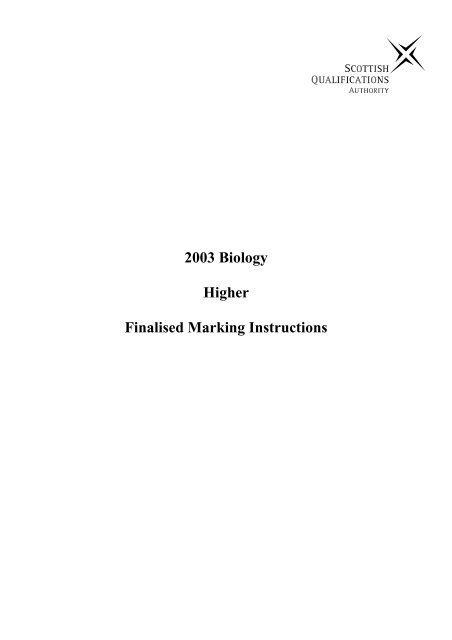
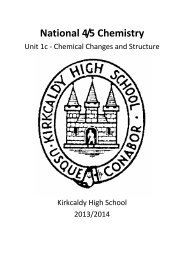
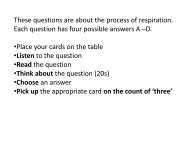
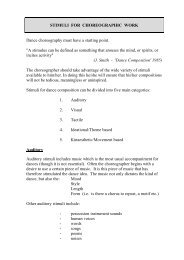

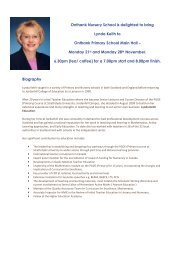
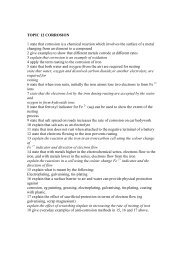

![Eastwood_Area_Catchment_updated_16-5-11[1]](https://img.yumpu.com/17146012/1/184x260/eastwood-area-catchment-updated-16-5-111.jpg?quality=85)
